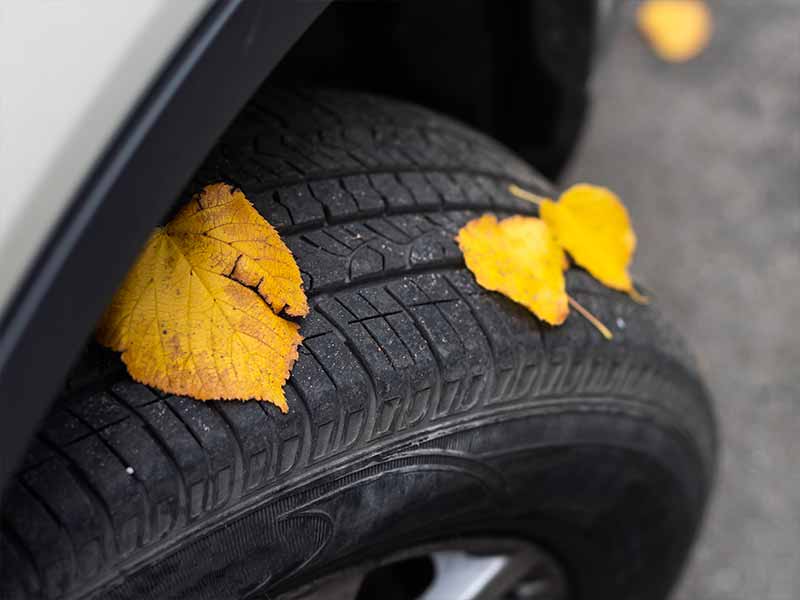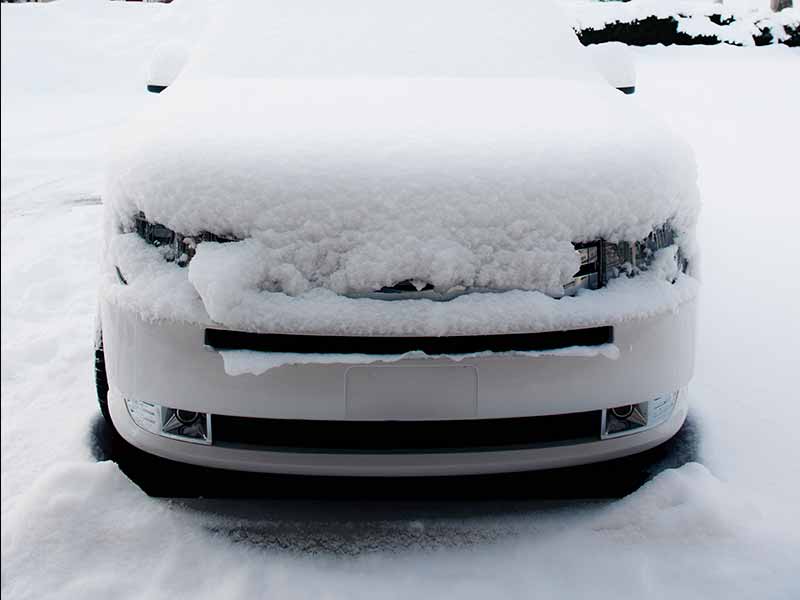Ever been puzzled by your car’s tire pressure warning light flashing on a cold morning, even though everything seemed perfectly fine the day before?
Well, you’re not alone! This is a common phenomenon that many drivers face during the cooler months of the year, and the reason might surprise you.
Why Do Tires Lose Pressure In Cold Weather?
Tires lose pressure in cold weather due to the Ideal Gas Law – as temperature decreases, so does the pressure inside the tire. This happens because the air molecules inside the tire move less and take up less space when it’s cold, resulting in lower tire pressure.
In this article, we’ll unpack the mystery of fluctuating tire pressure, exploring the science behind why tires lose pressure in cold weather, and how temperature shifts impact tire pressure.
We’ll also delve into the effects of driving with low tire pressure and share some practical tips for maintaining optimal tire pressure in cold weather conditions. So, buckle up and get ready for a deep dive into the world of tire pressure!
Let’s take a closer look.

Understanding Tire Pressure
It may sound like a mundane topic, but trust me, understanding how air pressure in your tires works can be a game-changer when it comes to your vehicle’s performance and your safety.
What Is Tire Pressure?
Tire pressure, in simple terms, is the amount of air in your car or truck’s tires. It’s typically measured in PSI (Pounds per Square Inch). To paint a picture, imagine a basketball. When it’s pumped up with the right amount of air, it bounces well and works perfectly for a game. But, if it’s under-inflated, it won’t bounce as well, and if it’s over-inflated, it could burst. Tires work pretty much the same way!
Why Is Tire Pressure Important?
- Safety: Under-inflated or over-inflated tires can lead to accidents. They affect your vehicle’s ability to brake effectively and can even lead to tire blowouts!
- Performance: Maintaining the right tire pressure ensures that your vehicle handles as it should, offering optimal grip, braking, and cornering.
- Fuel Efficiency: Believe it or not, tire pressure can affect your fuel efficiency. Improper tire pressure increases rolling resistance, which means your vehicle uses more gas to keep moving.
Ideal Tire Pressure: Is There A Magic Number?
That brings us to an important question: “What is the ideal tire pressure?” Well, there’s no one-size-fits-all answer to this because it depends on your specific vehicle. Here are some general tips:
- Your vehicle’s recommended tire pressure is usually found on a sticker in the driver’s side door jamb, or in the vehicle owner’s manual. This isn’t a random number but has been determined by the vehicle manufacturer for optimal performance and safety.
- Passenger cars generally have a recommended tire pressure between 30 and 35 PSI, while trucks often require a higher PSI due to their heavier weight.
- Remember, it’s not advisable to inflate your tires to the maximum PSI listed on the tire itself. That’s the maximum the tire can handle, not necessarily what’s best for your vehicle’s performance and safety.

Tire Pressure and Temperature: The Connection
So, now that you have a handle on tire pressure, let’s look at how it changes with the weather. Yes, you heard right! Your tire pressure can swing along with the mercury on your outdoor thermometer. Let’s unpack this a bit more.
The Science Behind Tire Pressure and Temperature
The reason tire pressure changes with temperature comes down to some pretty cool (and simple) science. Remember hearing about the Ideal Gas Law in science class? It basically says that the pressure of a gas is directly related to its temperature. As things cool down, pressure goes down. When things heat up, pressure rises.
This happens because air molecules are always moving. When it’s warm, they move around more, and this movement creates pressure on your tires’ insides. But as it gets cold, these molecules slow down and don’t hit the sides of your tires as often or as hard. That’s why your tire pressure drops in the cold!
How Does This Affect My Tires?
Cold weather can cause your tires to become under-inflated, meaning they don’t have enough air pressure. This can lead to some issues:
- Poor Handling: Under-inflated tires can make your vehicle harder to handle, reducing your control and making it harder to steer, brake, and accelerate.
- Reduced Fuel Efficiency: As we mentioned earlier, incorrect tire pressure can cause your vehicle to consume more fuel. And with fuel prices these days, who wants that?
- Increased Tire Wear: Tires that are under-inflated wear out more quickly, especially on the edges. This means you’ll need to replace them sooner, and that can be costly!
At What Temperature Do Tires Start Losing Air?
Got your jacket on and hot cocoa in hand? Good, because we’re going to talk about the point at which the cold starts to mess with your tires. The temperature drop causing a noticeable change in your tire pressure isn’t as severe as you might think.
When Does The Cold Start Impacting My Tires?
Here’s something that might surprise you. For every 10-degree drop in temperature, your tire pressure can drop about 1 PSI. So, if the temperature goes from a comfy 70 degrees Fahrenheit to a chilly 30 degrees, your tires could lose about 4 PSI!
Remember, this doesn’t mean your tires are leaking. It’s just the air inside them getting compact due to the cold. But why does a seemingly small PSI drop matter, you ask?
Why Is A Small PSI Drop A Big Deal?
Well, remember the recommended tire pressure range we discussed earlier – around 30 to 35 PSI for most passenger cars? Now consider this: if your tires lose 4 PSI due to cold weather, they could be under-inflated by over 10%. That’s enough to impact your vehicle’s performance and safety!
Does Snow or Ice Make A Difference?
Now, this is a common myth. Snow or ice outside doesn’t directly cause your tires to lose more air. It’s all about the temperature. Of course, driving on snowy or icy roads has its own challenges, but that’s a topic for another day!

Effects of Driving with Low Tire Pressure
Now that we’ve delved into how temperature changes impact your tire pressure, let’s discuss what happens if you continue to drive with low tire pressure. Spoiler alert: it’s not a good idea!
Is It OK To Drive with Low Tire Pressure?
Let’s cut to the chase here: No, it’s not advisable to drive with low tire pressure. Even a small PSI drop can make a big difference! Here’s why:
- Safety Risks: Low tire pressure can cause your tires to overheat, which can lead to tire failure. We’re talking blowouts and flats, neither of which are fun experiences, especially when you’re cruising on the highway!
- Poor Handling: When your tire pressure is low, your car might not respond to steering as quickly or accurately as you’d expect. This reduced handling can make it tougher to control your car, especially in emergency situations.
- Increased Wear and Tear: Low tire pressure increases the tire’s contact area with the road. This can lead to uneven and premature tire wear, forcing you to replace your tires sooner.
Does Low Tire Pressure Impact Fuel Efficiency?
You bet it does! If your tires are under-inflated, they create more resistance when rolling along the road. Your engine has to work harder to keep the car moving, which can guzzle more gas. So, maintaining correct tire pressure can help you save money at the gas station.
Can I Drive A Short Distance with Low Tire Pressure?
While it might be tempting to ignore that tire pressure warning light for a quick trip to the grocery store, it’s best to avoid driving any distance with low tire pressure. The risks just aren’t worth it.

Maintaining Tire Pressure in Cold Weather
We’ve explored the why’s and how’s of tires losing pressure in cold weather. Now, let’s arm ourselves with some tips and tricks to keep our tires in tip-top shape during those frosty winter months.
When Should I Check My Tire Pressure?
You might be tempted to check your tire pressure as soon as you hop in your car on a cold morning, but hold up! It’s best to check tire pressure when the tires are ‘cold,’ and by that, we mean when your car has been parked for a few hours. This ensures you get an accurate reading, not influenced by heat generated by recent driving.
How To Prevent Tires From Deflating In The Cold?
- Regular Checks: Keep a check on your tire pressure at least once a month, and always before a long trip. Remember, it’s normal for tires to lose some air over time, but you want to make sure it’s not dropping below the recommended PSI.
- Correct Inflation: If you find your tires are under-inflated, fill them up to the recommended PSI for your vehicle. Make sure not to overinflate though, as this can cause other issues!
- Use Nitrogen: Some people choose to fill their tires with nitrogen instead of regular air. Nitrogen molecules are larger than oxygen, so they’re less likely to seep out of your tires. Plus, nitrogen is less affected by temperature changes.
Should I Put Air In My Tires When It’s Cold?
Yes, if they are under-inflated. However, remember to go by the recommended tire pressure for your vehicle, not just the maximum listed on your tire.

I Recommend Every Keep A Portable Air Compressor In Their Car Or Truck
What About The PSI In Winter?
While it might be tempting to inflate your tires to the max PSI listed on the tire’s sidewall, don’t! That’s the maximum pressure the tire can handle, not the recommended pressure for your vehicle. Stick to the manufacturer’s guidelines, found in your owner’s manual or on the sticker in the driver’s side door jamb, even in winter.
Will My Tire Pressure Go Back Up When It Warms Up?
Absolutely, remember our chat about the Ideal Gas Law? When the temperature goes back up, the air inside your tires will expand, and your tire pressure should increase. However, you should still check your tire pressure regularly to ensure it’s within the recommended range.
Resources
Below are some links you may find helpful when learning about tires
- TPMS light coming on in cold weather? Heres why – Les Schwab
- Why tires go flat in cold weather – Consumer Reports
Final Thoughts
So, remember that flashing tire pressure warning light on a frosty morning? By now, you should have a pretty clear idea of why that happens and what you need to do about it. As the mercury dips, the air in your tires becomes less active and takes up less space, leading to lower tire pressure – a fascinating application of the Ideal Gas Law, right there in your driveway!
The key takeaway here is that maintaining the right tire pressure is vital for your vehicle’s performance, safety, and fuel efficiency, especially during colder months. Regular checks and adjustments to your tire pressure can save you from a potential blowout and even save you money on fuel.
Good luck and happy motoring.





